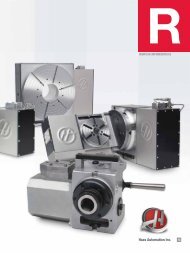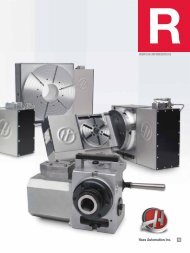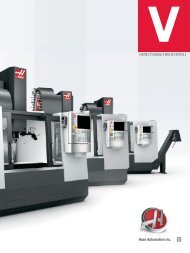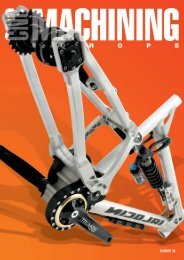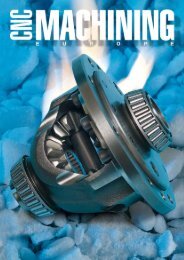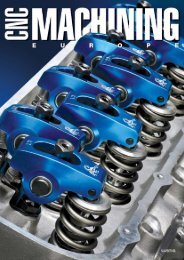NUMBER 02 - Haas Automation, Inc.
NUMBER 02 - Haas Automation, Inc.
NUMBER 02 - Haas Automation, Inc.
You also want an ePaper? Increase the reach of your titles
YUMPU automatically turns print PDFs into web optimized ePapers that Google loves.
0 | www.<strong>Haas</strong>CNC.comSIDEBAR<br />
The Derailleur<br />
and the G-Boxx<br />
The derailleur is a device used on chain-driven bicycles to allow gear changes – rather like the transmission effects<br />
gear changes on an automobile. The concept dates back to 1905, when touring cyclists used primitive derailleurs<br />
where the jockey wheel was brazed to the chainstay. Often disallowed in road racing in those days, derailleurs required<br />
freewheeling, which gave their users a considerable advantage over fixed wheel riders who had to contend with peddle<br />
scrape in turns.<br />
This changed in 1938, when Simplex introduced a revolutionary derailleur having a jockey wheel capable of moving<br />
in and out to effect gear changes, while also moving forward and backward according to the size of the sprocket.<br />
Simplex’s design incorporated a cage similar to those still in use on some derailleurs to take up slack in the chain.<br />
However, the Simplex system had a serious weakness: it was very sensitive to dirt and debris, and required frequent<br />
cleaning and lubrication. Despite this, it was so successful that it was immediately allowed in the Tour de France, and<br />
dominated racing through World War II.<br />
After the War, Tullio Campagnolo invented the parallelogram front and rear derailleurs, which revolutionized<br />
cycling in the post-War decades. Campagnolo’s parallelogram system was fast and more reliable than the Simplex<br />
design, and the cable-operated front derailleur was a dream compared to previous systems. “Campy equipped”<br />
became the motto for professionals and serious amateurs the world over. Later modified by Suntour, the basic<br />
Campy design remains in wide use today.<br />
However, the last couple of decades have brought tremendous change to the biking world, including the<br />
emergence of competitive mountain biking. This relatively new sport – accompanied by significant advances in<br />
bicycle frame design, construction materials and suspension technology – has brought many new challenges<br />
to bike riders, designers and manufacturers. For example, when you’re hurtling down a rocky mountain pass at<br />
anything up to 80 kph, the last thing you really want is a vital and fragile derailleur dangling from the rear of the<br />
frame, vulnerable to damage from rocks or a spill. So in 1999, Karlheinz Nicolai set out to find an alternative<br />
solution to the exposed derailleur.



